
* The Brazilian government formally established "Empresa Brasileira de Aeronautica (Embraer)" as a state-owned corporation for aircraft development and manufacture in the 1960s, the firm later being privatized. Early on, Embraer achieved commercial success with the "EMB 110 Bandeirante" twin-turboprop light airliner, which led to the similar but larger "EMB-120 Brasilia". It was only a relatively short step from there to develop a small jetliner, the "ERJ-145", which would lead in turn to the larger "ERJ-170" and "ERJ-190". This document provides a history and description of the Embraer jetliner and business jet family.

* In 1989, Embraer proposed a jet-powered derivative of the company's EMB-120 Brasilia, to be designated the "Embraer 145 (EMB-145)". The new small jetliner would leverage as much as possible off the Brasilia, only introducing new technology when it was cost-effective. As it turned out, in the course of development more changes were added, and eventually the new aircraft departed significantly from the Brasilia -- retaining much the same fuselage and tee tail, but with new swept wings, revised landing gear, and twin turbofans mounted alongside the tail.
Initial plans were for first deliveries in 1993, but funding cutbacks delayed the initial flight of the prototype of the "Embraer Regional Jet 145 (ERJ-145)", as it had been redesignated, to 11 August 1995. The single prototype was followed by three pre-series aircraft, leading to initial production deliveries in December 1996 to the US carrier Continental Express. The initial version of the ERJ-145 was the "ERJ-145ER", the "ER" standing for "extended range"; plans for production of the baseline "ERJ-145" AKA "ERJ-145STD" subvariant with shorter range were dropped, making the ERJ-145ER the effective baseline version.
The ERJ-145, as introduced, was made primarily of aircraft aluminum alloy. All flight surfaces were swept, with the low-mounted wing featuring a sweep of about 23 degrees at quarter chord. Each wing was fitted with a hydraulically-actuated aileron, with inboard and outboard flaps, both of them double slotted and electrically actuated. There were two spoilers ahead of the inboard flap on top of the wing, one for an airbrake, both operating as ground spoilers. The swept tailfin featured a two-section rudder, hydraulically actuated, and a forward fin fillet. The swept tailplane featured mechanically controlled elevators, along with a pitch trim system. Flight surfaces and engine inlets were de-iced by engine bleed air -- the cockpit windscreen was de-iced electrically.
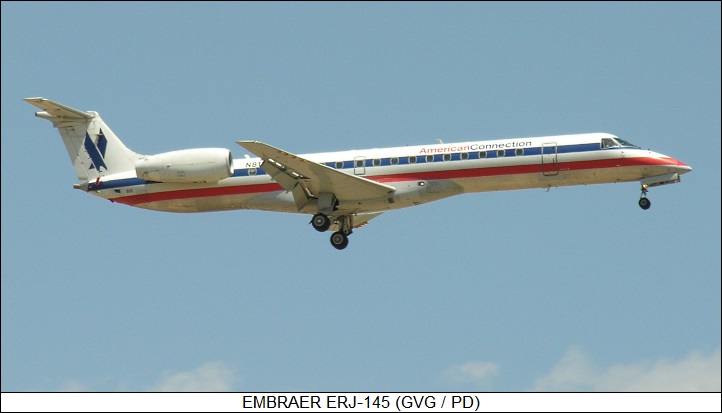
The ERJ-145 featured tricycle landing gear, all gear assemblies with dual wheels, the steerable nose gear retracting forward, the main gear pivoting from the wings into the wing-fuselage fairing. There were no main gear doors. The jetliner was powered by twin Allison AE 3007A turbofans with 31.3 kN (3,190 kgp / 7,040 lbf) thrust each, clamshell thrust reversers being optional. There was an auxiliary power unit (APU) turbine engine in the tailcone for engine starting and ground power. The ERJ-145 was fitted with the Honeywell Primus 1000 glass cockpit system, linked to color weather radar.
The ERJ-145 had a crew of three, including pilot, copilot, and flight attendant; 50 passengers could be carried, sitting three abreast. There was a galley and a baggage compartment forward for carry-on baggage, plus a lavatory and main baggage compartment in the rear. The main door, in fold-down airstair configuration, was on the forward left side of the fuselage, with a service door on the right side; there was an emergency exit above each wing, plus a door on the left for the rear baggage compartment.
___________________________________________________________________
EMBRAER ERJ-145:
___________________________________________________________________
wingspan:
20.04 meters (65 feet 9 inches)
wing area:
51.18 sq_meters (551 sq_feet)
length:
29.87 meters (98 feet)
height:
6.75 meters (22 feet 2 inches)
empty weight:
17,900 kilograms (39,460 pounds)
loaded weight:
22,000 kilograms (48,500 pounds)
normal cruise speed:
830 KPH (515 MPH / 445 KT)
service ceiling:
11,300 meters (37,000 feet)
range:
2,875 kilometers (1,350 MI / 1,550 NMI)
___________________________________________________________________
Embraer subsequently introduced a confusing set of subvariants -- including the "LR", "LU", "MK", "MR", "MP", "EP", and "EU", with the baseline machine redesignated "ERJ-145STD" -- which were all but identical externally but offered options such as increased fuel, higher maximum take-off weight, and engines with better "hot and high" performance. A more distinctive "ERJ-145XR" variant was introduced in 2003, featuring range increased by 25% relative to the baseline ERJ-145ER; aerodynamic improvements, most notably winglets; a reinforced airframe; and AE 3007A1E turbofans with better specific fuel consumption, plus enhanced "hot and high" performance.
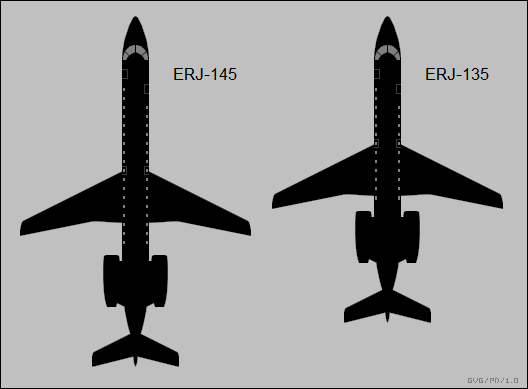
Embraer also developed two "shortened" derivatives of the ERJ-145, the "ERJ-135" and "ERJ-140":
Embraer, finding the ERJ popular, decided to develop an executive / VIP derivative of the ERJ-135, originally the "EMB-135BJ" but introduced as the "Legacy 600", with initial deliveries in 2002. It altered the ERJ-135 airframe with an extended wing-body fairing for more fuel tankage, and had winglets. It was followed by the "Legacy 650", much the same but with more range, initial deliveries being in 2011. Embraer has also offered a "Legacy Shuttle", which by descriptions was more or less a standard ERJ-135LR configured for the corporate shuttle role, with options for 16 to 19 passengers in first-class seating, or 37 with a more conventional airliner interior. From 2020, Embraer offered "combi" -- combined freight / passenger configurations -- of the ERJ-145. More recently, the company has offered conversions to a "semi-private" configuration, with reduced seating -- only one seat on each side of the aisle -- and no overhead bins.

In 2002, Embraer announced a co-production deal with the Harbin Aircraft company of China for manufacture of the ERJ-145 series. The first Chinese aircraft was delivered in late 2003 -- but sales of Harbin-built machines were very sluggish, and the joint venture was abandoned in 2016. Overall, however, the ERJ-145 family has proven highly successful, with over 1,200 machines sold to date.
BACK_TO_TOP* A few more or less stock ERJ-145-series airliners have been operated by military forces as personnel or VIP transports; the Brazilian Air Force (FAB in its Portuguese acronym) has operated a number of different configurations as the "C-99" or VIP "VC-99". Embraer has also promoted the ERJ-145 as a specialized military platform under the designation of "EMB-145", and has achieved moderate sales of such machines, in three general configurations:
The FAB designations are employed here for simplicity, though not all operators adopted them. The E-99 AEW machine was fitted with the Swedish PS-890 Ericsson Erieye AEW radar. The FAB was the launch customer, buying five aircraft. Initial flight of a modified airframe was in 1999; systems integration was performed by Raytheon in the USA, with deliveries of the five FAB machines in 2002:2003. Greece has also obtained four, with service entry in 2008; Mexico one, from 2004; and India three "EMP-145I" machines, introduced into service in 2014.
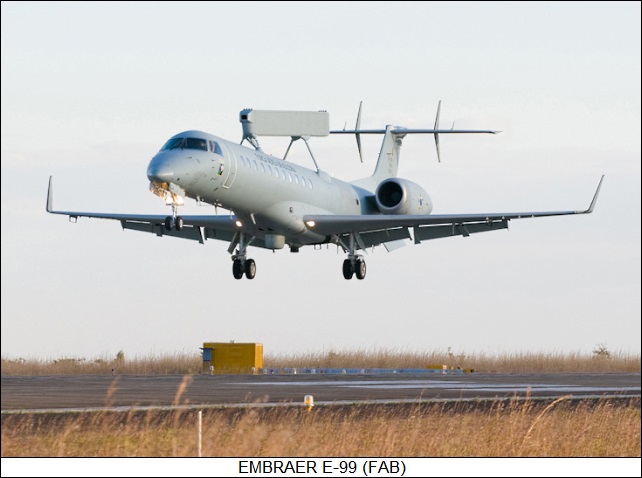
The Erieye featured a long "active array" antenna carried on the back of the aircraft, with the antenna consisting of 192 "transmit-receive" modules. The Erieye was capable of tracking hundreds of targets at once at a maximum radius of about 460 kilometers (286 miles), and could deal with both airborne and water-borne targets, using four different waveform modes. It was capable of wide-area search, or close examination of targets with a high-power narrow beam.
The E-99 carried a suite of signals intelligence (SIGINT) gear and an Identification Friend or Foe (IFF) transponder as well. The E-99 was also equipped with GPS navigation and secure comlinks. There were four operator consoles in total, plus seats for five relief crew, along with the flight crew of two. The E-99 featured winglets, plus twin ventral fins under the tail and swept "finlets" on the tailplane to compensate for the aerodynamic clutter of the Erieye antenna; it had a reinforced airframe, a more powerful APU, a more capable electric system, and additional fuel tanks to extend endurance to eight hours. The five E-99 machines have been upgraded to "E-99M" configuration, with an updated mission system, with redeliveries from 2020 to 2022.
The Mexican E-99 machine had an imaging turret under the nose, a feature not seen in the FAB or Greek machines; the Mexican aircraft has been heavily used in interdiction of drug trafficking. Indian machines had some Indian-built kit, including an indigenously-built active-array radar; while the E-99 aircraft flown by the other operators tended to be littered with a substantial number of antennas, the Indian machines were particularly "warty", with antenna fairings all over the aircraft. Indian machines also had a third "finlet", essentially an extension of the tailfin, and a fixed probe for hose-&-drogue inflight refueling protruding from above the right side of the cockpit. India has an option for buying seven more E-99 machines.
* The FAB was the only operator of the R-99 surveillance platform, ordering three, with initial aircraft delivery in 2001 and final delivery in the spring of 2002. The primary sensor of the R-99 was the Canadian-built MacDonald-Dettwiler "IRIS (Integrated Radar Imaging System)" SAR with three-dimensional imaging capabilities -- the antenna being installed in a fairing under the belly, with auxiliary "cheek" fairings alongside the fuselage forward of the wings; a Daedelus multispectral scanner; a "Skyball" EO/IR turret; and the same SIGINT suite as used on the E-99. The airframe had ventral fins and presumably additional fuel tankage; it did not have finlets on the tailplane, nor did it have winglets.
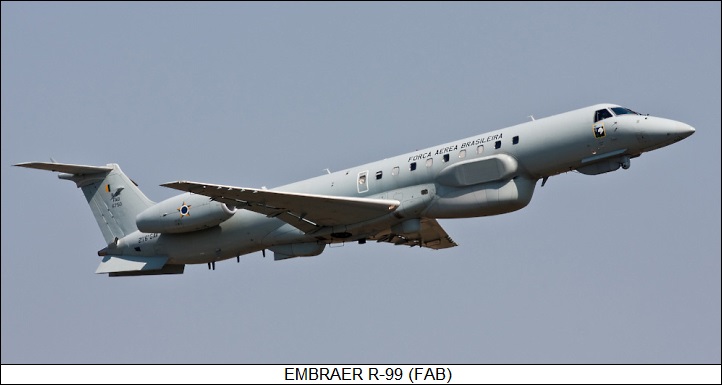
In 2004, the US Army awarded Embraer a development contract for what amounted to an R-99 with US-supplied kit under the "Airborne Common Sensor (ACS)" program. That was a significant win for Embraer, with 34 ACS aircraft planned -- but the ACS program was canceled in 2006, and it came to nothing.
* Mexico was the only user of the P-99 maritime patrol variant, obtaining two. It was along the lines of the R-99, with a belly radome (for Raytheon SeaVue surface search radar) but no cheek fairings; a retractable infrared imaging turret; a SIGINT suite; and two stores pylons inboard under each wing, for a total of four, munitions including homing torpedoes and antiship missiles. It had ventral fins but no winglets, and presumably additional fuel tankage. Delivery appears to have been in 2003, with the machine being heavily used in interdiction of drug trafficking. Embraer has promoted this configuration for antisubmarine warfare as well, presumably with the addition of a sonar buoy dispenser and magnetic anomaly detector tailboom.
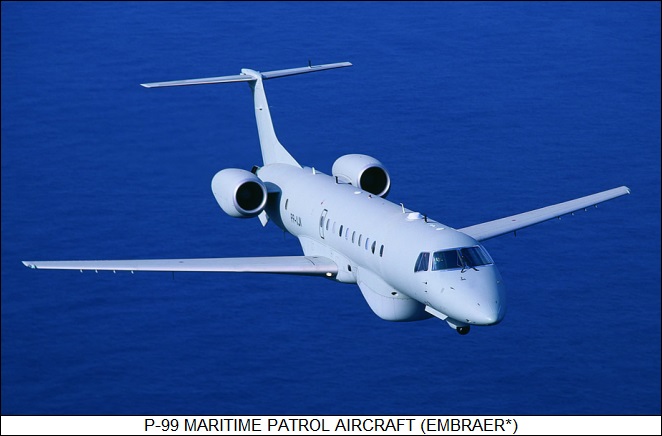
* The E-99 and R-99 became central elements of Brazil's System for Vigilance of the Amazon (SIVAM)" program, run by the Brazilian Air Force. Brazilian authorities have an immense problem in monitoring activities in the huge Amazon region, which covers about 5.2 million square kilometers (2 million square miles), about the size of the US to the west of the Mississippi River.
They believe with good reason that much of what is going on there unknown to the authorities isn't good -- illegal logging and mining, smuggling, drug manufacture, plus insurgent training and support. The SIVAM network integrates ground stations, air platforms, and satellite data linked through an extensive communications network to ground centers to observe what is going on in the jungle region. Incidentally, satellite data is now being provided by the "China Brazil Earth Resource Satellite (CBERS)" series of spacecraft, which as the designation states are being developed in collaboration with China, and are launched by Chinese boosters.
The E-99 monitors air and water traffic, while the R-99 observes what is going on down on the ground, with both platforms performing SIGINT operations to observe what's going on over the airwaves. The systems of the two types of machines were built so they could operate simultaneously without interfering with each other, while they stay on station for six-hour shifts. The R-99's SAR system is particularly useful, since the Amazon is very rainy much of the year, and many illegal activities are carried out during the rainy season when they are harder to detect.
If the aircraft spot targets that need to be dealt with, such as clandestine jungle airstrips, they can call on paramilitary forces and Embraer Super Tucano light strike aircraft to take them out. SIVAM is directed from a large "campus" at Manaus, in the heart of the Amazon region; surveillance data from the aircraft, ground SIGINT stations, and CBERS satellites are analyzed and integrated at this site, and used to plan responses. The R-99s have proven so effective that drug dealers have assigned "eyes" to keep track of their comings and goings at Anapolis AFB, near Brasilia. The eyes report in with cellphones, which are ironically often picked up by the SIGINT gear on board the aircraft. SIVAM elements like the E-99 and R-99 have been involved in cooperative operations with Brazil's neighbors, such as locating bases set up by Peruvian Shining Path guerrillas.
The R-99 also performs resource mapping and pollution monitoring, and can help in fire-fighting by locating infrared "hot spots" on the ground through the smoke. These sorts of tasks are often used in support of the "System for the Protection of the Amazon (SIPAM)", a civilian-run organization that complements SIVAM. SIPAM is referred to as a "green" organization, with an environmental focus, while SIVAM is a "blue" organization, with an air power / intelligence focus.
The E-99s and R-99s received upgrades to bring them up to "E-99M" and "R-99M" standard, with the upgrades featuring AE 3007 A1P engines with 20% more thrust and thrust reversers, as well as system upgrades to improve their effectiveness. Redeliveries were from 2020.
BACK_TO_TOP* Encouraged by customer enthusiasm for the ERJ 145, in 1998, Embraer began studies on a larger regional jet with a capacity of 70 or 90 seats. In early 1999, Embraer announced an intent to develop an "ERJ-170" with 70 seats and an "ERJ-190" with 90 seats -- which were later formally renamed the "Embraer 170 (E170)" and "EMBRAER 190 (E190)", though it appears the "ERJ" designations were retained for paperwork purposes. Embraer would label the series the "E-Jets". The first prototype of the E170 was rolled out in October 2001 and performed its first flight in February 2002. Deliveries were delayed to 2004.
As introduced the E170, AKA "ERJ-170-100", was a twin-jet aircraft of mostly aluminum alloy construction along with some composite assemblies, with a General Electric CF34-8E turbofan engine with 41.9 kN (4,270 kgp / 14,000 lbf) thrust on a pylon under each wing, the engines featuring thrust reversers. An APU was fitted in the tailcone. All landing gear assemblies had twin wheels, the nose gear retracting forward, the main gear pivoting from the wings in towards the fuselage; as with the ERJ-145, there were no doors over the main gear wheels. Wings and the engine cowlings were de-iced by bleed air; the windscreen was electrically de-iced.
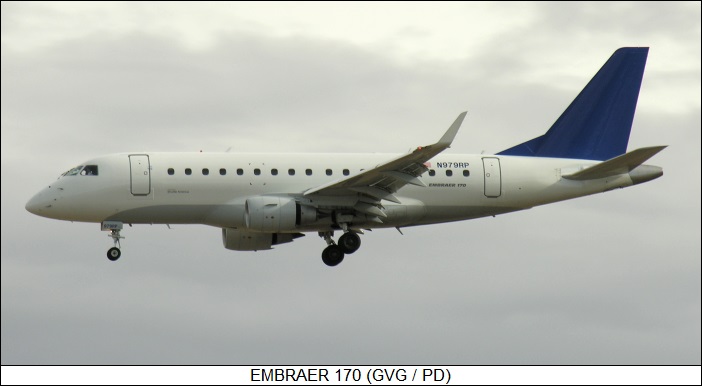
All flight surfaces were swept, with wings featuring winglets, two-section double slotted flaps, ailerons, full-span leading-edge slats in four segments, and five spoilers -- three ahead of the outboard flap for multipurpose use, two ahead of the inboard flap for ground braking. The tailfin had a leading-edge fillet, the tailplane had elevators plus all-moving trim. The rudder and elevators were electronically actuated, though the ailerons were still manually controlled.
The E170 had a crew of two; it was fitted with the Honeywell Primus Epic glass cockpit avionics suite, and had color weather radar. It had a capacious "double-bubble" fuselage that typically seated 70 to 76 passengers in a four-abreast configuration. There was a lavatory and a galley fore and aft. There were passenger doors fore and aft on the left side of the fuselage, with roughly parallel service doors on the right side of the fuselage. The cockpit side windows could be used for crew escape. Baggage was stowed in forward and aft holds under the floor, with doors set low on the right side of the aircraft.
___________________________________________________________________
EMBRAER 170:
___________________________________________________________________
wingspan:
26 meters (84 feet 4 inches)
length:
29.9 meters (98 feet 1 inch)
height:
9.67 meters (32 feet 4 inches)
empty weight:
21,140 kilograms (46,600 pounds)
max take-off weight:
35,990 kilograms (79,300 pounds)
take-off field length:
1,675 meters (5,500 feet)
cruise speed:
870 KPH (540 MPH / 470 KT)
service ceiling:
12,500 meters (41,000 feet)
range:
3,335 kilometers (1,565 MI / 1,800 NMI)
___________________________________________________________________
The E170 has also been offered in "E170LR" and "E170AR" subvariants, with longer range and increased gross weight respectively.
The E170 was followed by a slightly stretched variant, the "Embraer 175" AKA "ERJ-170-200", extended by 1.78 meters (5 feet 10 inches), to 31.68 meters (103 feet 11 inches), with empty weight increased by 3% and passenger capacity raised from 78 to 86 seats. First flight of the E175 was in 2003, with introduction to service in 2005; it has been offered in "E175LR" and "E175AR" subvariants as well.

The Embraer 190 AKA "ERJ-190-100" was similar to the E170, except for obvious differences such as:
Initial flight of the E190 was on 7 December 2004, with deliveries from September 2006. It has also been offered in "E190LR" and "E190IGW" subvariants, with increased range and increased gross weight respectively. An executive / VIP version of the E190LR, the "Embraer Lineage 1000", was also offered up to 2020.
An "Embraer 195" AKA "ERJ-190-200" was introduced in parallel with the E190, the E195 featuring a fuselage stretch of 2.41 meters (7 feet 11 inches), to 38.65 meters (126 feet 10 inches), providing a typical capacity of from 108 to 110 passengers. "E195LR" and "E195IGW" subvariants have been on offer as well.
Over 1,650 E-Jets machines have been sold to date. It is unclear if there have been any military buyers; certainly there's been no mention of special-mission aircraft. Embraer has introduced a second generation of "E-Jets", the "E2 Series", with the initial "E190-E2" rolled out in early 2016, and initial customer delivery in 2018. It was followed by the "E195-E2", with rollout in 2017, and initial customer delivery in 2019; the "E175-E2" was rolled out in 2019, with initial customer deliveries in 2021. The E170 has been be dropped, reflecting a bias against smaller-capacity regional jetliners.
The primary change in the E2 series was replacement of the GE CF34 engine by the Pratt & Whitney "PurePower" PW1900G geared turbofan. The updated engines provided about 11% better fuel economy; flight efficiency was also enhanced by a wing with greater span and aerodynamic refinements -- yielding a further 3.5% reduction in fuel burn -- and a new fly-by-wire flight control system developed with Moog -- to provide another 1.5% improvement in efficiency.
The wing was redesigned, featuring raked wingtips, with span increased by about 5 meters (16 feet). There was a general tidying up of aerodynamics, with the main gear featuring doors over the wheels. The cockpit was arranged around a Honeywell Primus Epic 2 suite, featuring four large displays, plus a synthetic vision system. Other changes were introduced to make the E2 series easier to maintain, notably a new air data system named "SmartProbe", replacing the traditional pitot tube.
In the interim before deliveries, Embraer offered a software update for current E175s, at least those with the more recent wing profile, to improve range performance when operating out of "hot and high" airports. In addition, as of 2022, Embraer was offering "passenger to freighter (P2F)" conversions of E-Jets, with initial deliveries in 2024.
BACK_TO_TOP* Following up the development of regional jetliners and their executive aircraft derivatives, Embraer moved on to business jets. The first, the "Phenom 100" was announced in 2005, at a time when there was a craze for "very light jets (VLJ)".
VLJs were effectively small business jets, with a notion being floated around that VLJs would be the backbone of a burgeoning "air taxi" business, with swarms of small jets flying passengers from small airport to small airport on demand. How seriously Embraer brass took the VLJ concept is unclear, but in any case it went out to sea, and the Phenom 100 ended up being just a small business jet. The first of four Phenom 100 prototypes performed its initial flight in July 2007, with the first production machine being delivered in 2008.

As introduced, the Phenom 100 was a tidy little jet, with some styling similarity to the earlier Embraer Xingu twin-turboprop business aircraft -- though the Phenom 100 was a largely or entirely new design. It was built of aircraft aluminum alloy with considerable use of composite assemblies, and featured:
Flight surfaces were conventional and manually-actuated; each wing had two fences, and there was a fixed ventral fin under the tail. Wings and tailplane featured de-icing boots; engine inlets were de-iced by bleed air, while the windscreen was electrically de-iced. All landing gear assemblies had single wheels, the nosewheel retracting forward, the main gear pivoting from the wings in towards the fuselage. The main gear had no wheel covers. Powerplants were Pratt & Whitney Canada (PWC) PW617F-E turbofans with 7.2 kN (770 kgp / 1,695 lbf) thrust each and FADEC.
___________________________________________________________________
EMBRAER PHENOM 100:
___________________________________________________________________
wingspan:
12.3 meters (40 feet 4 inches)
length:
12.8 meters (42 feet 1 inch)
height:
4.4 meters (14 feet 3 inches)
empty weight:
3,235 kilograms (7,132 pounds)
MTO weight:
4,750 kilograms (10,470 pounds)
max cruise speed:
720 KPH (450 MPH / 390 KT)
service ceiling:
12,500 meters (41,000 feet)
range:
2,180 kilometers (1,025 MI / 1,180 NMI)
___________________________________________________________________
The cockpit featured a Prodigy flight deck, based on the Garmin G1000, with three flat-panel displays, and the aircraft was fitted with Garmin weather radar. The Phenom 100 could be flown by one or two crew. Four passengers could be seated in a club arrangement; six was more efficient; accommodations for eight were available as well, but apparently the expectation in that case was that some of the passengers would be kids. A belted lavatory seat was optional. Of course, accommodations were pressurized and climate-conditioned. There was an airstair door on the forward left fuselage, and an emergency exit over the right wing. Baggage could be stowed in the nose, or in a rear baggage hold between the engines, with access doors for the holds on the left. Space for baggage in the passenger cabin of course varied with seating arrangement.
Over 350 Phenom 100 jets have been shipped to date; the aircraft has been regarded as luxurious for its class and pleasant to fly. A modest update, the "Phenom 100E", replaced the original Phenom 100 in production from 2014, the Phenom 100E featuring ground spoiler / speed brakes to reduce landing roll, plus an updated Garmin cockpit, and new interior options.
A substantially improved "Phenom 100E" -- for "EVolution" -- was introduced in 2017, featuring an enhanced Garmin 3000 cockpit and PW617F1-E turbofans with 79.4 kN (770 kgp / 1,730 lbf) thrust each, 2% more than the earlier engines. Along with executive aircraft use, a number of Phenom 100s went into service as government / military VIP / liaison transports and multi-engine flight trainers -- the British Royal Air Force having obtained an initial batch of five for the flight training role. Upgrades, for example improved flight decks, were offered for older Phenom 100s.
* Embraer also pursued development of a slightly larger small business jet, which emerged as the "Phenom 300", the first of three prototypes performing its initial flight on 29 April 2008. Certification was obtained in 2009, with customer shipments at the end of the year. Although it is unclear how much commonality there was between the Phenom 100 and Phenom 300, the Phenom 300 could be described as Phenom 100 stretched by 22% and roughly twice as heavy, with swept wings featuring winglets and more powerful engines.

Fuselage diameter of both aircraft was the same; both had the same engine placement, tail, landing gear, door, and cargo hold configurations, if not necessarily using the same hardware. As with the Phenom 100, the Phenom 300 featured a Prodigy flight deck and dual controls, with manually actuated flight surfaces; there were six or seven passenger seats.
___________________________________________________________________
EMBRAER PHENOM 300:
___________________________________________________________________
wingspan:
16.2 meters (53 feet 2 inches)
length:
15.9 meters (52 feet 2 inches)
height:
5 meters (16 feet 5 inches)
MTO weight:
7,950 kilograms (17,530 pounds)
max cruise speed:
835 KPH (520 MPH / 450 KT)
service ceiling:
13,700 meters (45,000 feet)
range:
3,650 kilometers (2,270 MI / 1,970 NMI)
___________________________________________________________________
The Phenom 300's wing featured inboard and outboard slotted flaps, with a split spoiler in front of each outboard flap. Powerplants were PWC PW535E turbofans, with 14.23 kN (1,450 kgp / 3,200 lbf) thrust, almost twice as much as the Phenom 100's PW617 engines.
An improved "Phenom 300E" -- "E" meaning "Enhanced" -- was introduced in two phases, with a relatively minor upgrade in 2018 and a bigger upgrade in 2020. It featured the latest Garmin touchscreen glass cockpit, with smart features including windshear prediction, an emergency descent mode, plus a runway overrun awareness & alerting system. It also had PW535E1 turbofans, providing increments in performance and range, along with a new Bossa Nova interior, wireless internet connectivity, and better noise-proofing.
A medical evacuation (medevac) configuration, the "Phenom 300MED", was also introduced in 2020, with one or two stretchers and medical support kit; it presumably used Phenom 300E enhancements. At last report, Embraer had sold over 530 Phenom 300s, including 70 Phenom 300Es.
BACK_TO_TOP* The Phenom series proving successful, Embraer then decided to develop the "Legacy 500" -- not a derivative of the Embraer 600/650, more along the lines of the Phenom 300 but larger. Development was announced in 2007, first flight of the prototype was on 27 November 2012, with certification and initial deliveries in 2014.
As introduced, the general configuration of the Phenom 300 and Legacy 500 was the same -- same flight surface configuration, the wings featuring winglets; same engine placement; same door arrangement, with airstair door forward on the left and an emergency exit over the wing on the right. Visible external differences, aside from size, were that the Legacy 500's wing had a sharper sweep on the inboard third of the wing versus the outboard two-thirds, and the main gear assemblies had dual wheels. Arrangement of control surfaces on the wing was unclear.
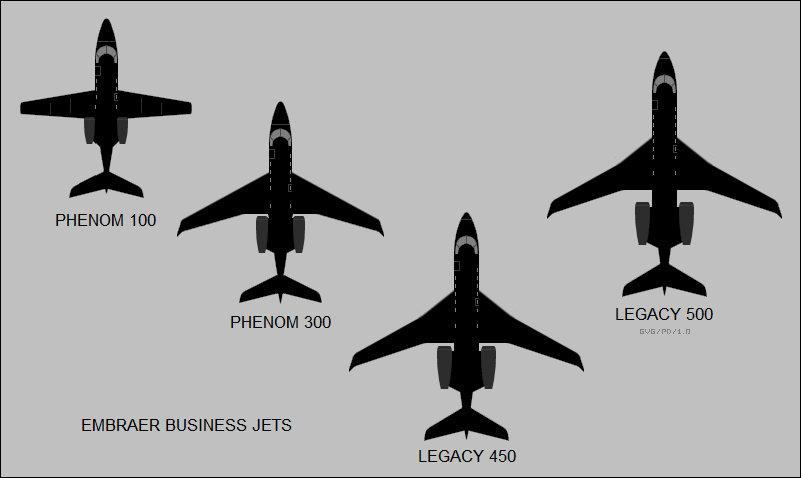
Powerplants were Honeywell HTF7500E turbofans with 29.7 kN (2,950 kgp / 6,500 lbf) thrust each. The flight deck was based on the Rockwell Collins Pro Line Fusion system; controls were fly-by-wire. There were dual controls, with seating for from 8 to 12 passengers. Galley and lavatory were standard; there was no nose baggage compartment. The larger size of the Legacy 500 gave stand-up room in the cabin.
___________________________________________________________________
EMBRAER LEGACY 500:
___________________________________________________________________
wingspan:
20.24 meters (66 feet 5 inches)
length:
20.52 meters (67 feet 4 inches)
height:
6.73 meters (22 feet 1 inch)
max cruise speed:
Mach 0.82
service ceiling:
14,000 meters (46,000 feet)
range:
5,555 kilometers (3,450 MI / 3,000 NMI)
___________________________________________________________________
In 2007, along with the Legacy 500 announcement, Embraer also announced development of the "Legacy 450", which was effectively the same as the Legacy 500 but reduced in length from 20.52 meters (67 feet 4 inches) to 19.15 meters (62 feet 10 inches), with passenger capacity accordingly reduced to from 7 to 9 passengers. Embraer was hoping to introduce both at the same time, but the Legacy 450 schedule slipped about a year behind that of the Legacy 500. First flight of the Legacy 450 was on 28 December 2013, with certification in 2015, and initial customer deliveries late in that year.
* In late 2018, Embraer unveiled the "Praetor 500" and "Praetor 600", which were updated versions of Legacy 450 and 500 respectively. The Praetor 500 could fly four passengers 6,010 kilometers (3,735 miles / 3,250 NMI) -- enough to get from Seattle to Miami, or San Diego to Boston, in the face of normal headwinds. The Praetor 600, with extra fuel tanks, could fly eight passengers 6,300 kilometers (4,485 miles / 3,900 NMI), enough for the New York-London route.
The Praetors were both powered by Honeywell HTF7500E; those of the Praetor 500 are rated at 29.1 kN (2,965 kgp / 6,540 lbf) take-off thrust, while those of the Praetor 600 are rated at 33.5 kN (3,425 kgp / 7,530 lbf). Both machines featured:
They used the same wing as the Legacy 500, which was discontinued following the introduction of Praetors, but with new blended winglets. The wing had more fuel capacity than the Legacy 450. The Praetor 600 had a larger belly fairing for bigger fuel tanks, with a prominent skid to protect it from runway strikes. The two machines were certified in 2019, initial deliveries being in that year. Legacy 450s could be upgraded to Praetor 500 standard, but the Legacy 500 couldn't be upgraded to the Praetor 600 standard.
The Melbourne, Florida, facility was expanded; it produced the Legacy 500, and will produce the Praetors. It produced the Legacy 450 up to 2020, when it was discontinued in favor of the Legacy 500. Embraer is also working with ELTA of Israel to develop a "P600 AEW" variant of the Praetor 600, using an advanced ELTA active-array radar, and other sensor systems. Full development is contingent on finding a buyer.
BACK_TO_TOP* Under the "Energia" effort, announced in 2021, Embraer is now developing a new generation of "green" commercial aircraft. The initial announcement included four concepts of varying size, featuring a range of technologies including electric, hydrogen fuel cell (H2FC), dual-fuel gas turbine, and hybrid-electric (HE). Concepts released so far have included:
Both would have rear-mounted electric fans. The H2FC variants require bulky hydrogen tanks and are bigger than their HE equivalents. At present, Embraer is aiming for the Energia Hybrid technology to be ready by the early 2030s, with the the Energia H2 Fuel Cell is 2035. Embraer officials see building up a "green" hydrogen infrastructure as problematic.
Over the shorter term, Embraer is working towards the launch of a 70:90-seat highly-efficient regional airliner, for service late in this decade. The aircraft would be based on the E-Jets and have rear-mounted turboprops. In addition, is considering a hybrid-electric "Short Take-off Utility Transport (STOUT)" with the Brazilian Air Force. Powered by two turboshafts generating electric power to drive four propellers, the STOUT is a light military transport also aimed at the civil cargo market. The plan is that these two aircraft would be powered by sustainable aviation fuel.
* This document was mostly constructed from volumes of JANE'S ALL THE WORLD'S AIRCRAFT, along with Embraer documentation and articles from the online Wikipedia.
* Revision history:
v1.0.0 / 01 jul 13 v1.0.1 / 01 may 15 / Review & update. v1.0.2 / 01 apr 17 / Review & update. v1.1.0 / 01 mar 19 / Review, update, & polish. v1.2.0 / 01 nov 19 / Cut out materials on KC-390 cargolifter. v1.2.1 / 01 feb 21 / Review, update, & polish. v1.2.1 / 01 feb 21 / Review, update, & polish. v1.2.2 / 01 jul 23 / Review, update, & polish.BACK_TO_TOP
